tags: evolutionary biology, paleontology, taphonomy, plumage color, feathers, color, melanin, eumelanin, phaeomelanin, dinosaurs, theropod, paravian, avialae, fossils, Anchiornis huxleyi, ornithology, birds, researchblogging.org,peer-reviewed research, peer-reviewed paper
New research reveals that recently-described 155-million-year-old Anchiornis huxleyi,
a woodpecker-like dinosaur the size of a modern-day domesticated chicken,
had black-and-white spangled wings and a rusty red crown.
Image: Michael DiGiorgio, Yale University [larger view]
Fig. 4. Reconstruction of the plumage color of the Jurassic troodontid Anchiornis huxleyi. The tail is unknown specimen BMNHC PH828, and reconstructed based on the complete specimen previously described. Color plate by Michael A. Digiorgio.
Ever since dinosaurs were discovered, scientists, artists and children everywhere have speculated about what they really looked like. Fossilized bones, skin impressions and recently, feathers, provide a general mental image of these animals' appearances, but these materials also leave important questions unanswered, basic questions such as what color were dinosaurs?
Originally, it was thought that we would never know the true colors of dinosaurs, but new technologies show that assumption is in error. Scanning electron microscopy now reveals that the 155-million-year-old paravian theropod, Anchiornis huxleyi, which resembles a large woodpecker, actually sported flashy black-white-and-red coloration.
But the new field of fossil feather color had an unlikely beginning: while squinting at electron photographs of ink sacs in ancient squid, Yale University graduate student, Jakob Vinther, suddenly realized that the microscopic grains he was seeing were not bacteria, as many scientists thought. Instead, these tiny structures appeared to be melanosomes -- organelles found inside cells that contain melanin, a light-absorbing pigment that gives color to fur and feathers alike.
Because melanins are also present in modern bird feathers, it just might be possible to use them to figure out the colors and color patterns of ancient birds and feathered dinosaurs, Mr Vinther proposed.
Mr Vinther tested his hypothesis by looking at a 112 million year old fossil feather from Brazil and then used those methods to infer the colors of an extinct 47 million-year-old bird, providing an intriguing glimpse into the colors and color patterns that might have existed in dinosaurs (DOI: 10.1098/rsbl.2008.0302).
That dramatic discovery inspired another team of British and Chinese scientists to examine bird-like dinosaur fossils that are covered with feather-like projections. They found that the bristles growing out of the skin of the 125-million-year-old species, Sinosauropteryx, also contained melanosomes. Based on their examinations, they concluded that the dinosaur had reddish-and-white rings along its tail as reported last week (DOI: 10.1038/nature08740).
Meanwhile, Mr Vinther continued his own work in collaboration with an international team of scientists. Together, they studied fossil feathers on the bird-like dinosaur, Anchiornis huxleyi, which was recently unearthed in Liaoning Province, China. This fossil is important in its own right because it is part of the growing body of fossil evidence confirming the once-controversial hypothesis that modern birds are descendants of theropod dinosaurs.
But it also has beautifully preserved feathers that contain melanosomes. The team deciphered the microscopic clues hidden within its feathers, bringing to light this creature's vibrant plumage colors for the first time in 155 million years.
"This was no crow or sparrow, but a creature with a very notable plumage," stated co-author Richard O. Prum, chair and the William Robertson Coe Professor of Ornithology, Ecology and Evolutionary Biology at Yale University, and thesis advisor to Mr Vinther.
To do this work, the team used scanning electron microscopy to examine 29 fossil feathers from all body regions of one spectacularly-preserved specimen of Anchiornis huxleyi (BMNHC PH828; Figures 1 & 2).
Fig. 1. Anchiornis huxleyi (BMNHC PH828) with scanning electron micrographs (SEMs) of samples from the feathers. (A) Part with inset of isolated right hindlimb. The left forelimb is seen in ventral view, the right in dorsal. (B) Explanatory drawing: numbered dots indicate samples from the part (red) and counterpart (blue). (CH) SEMs of melanosomes and melanosome impressions taken from samples 7 (C), 6 (D), 5 (E), 18 (F), 24 (G) and 21 (H). Abbreviations: (Ga) gastralia, (Fu) furcula, (Lh) left humerus, (Lm) left manus, (Lp) left pes, (Lr) left radius, (Ls) left scapula, (Lu) left ulna, (Mu) manual ungual, (Rh) right humerus, (Rm) right manus, (Rr) right radius, (Ru) right ulna, (Rs) right scapula. Scale bars: (A, B) 5 cm except insert, 2 cm; (C-H) 1 μm. [larger view]
DOI: 10.1126/science.1186290
Fig. 2. Anchiornis huxleyi (BMNHC PH828), isolated skull with SEMs of samples from the feathers. (C) Skull. (D) Explanatory drawing: numbered dots indicate samples. Abbreviations: (J) jugal, (L) lacrimal, (Ld) left dentary, (M) maxillare, (N) nasale, (Pm) premaxillare, (Rd) right dentary. (A, B, EE, FF) SEMs of samples 26 (A), 25 (B) and 27 (E, F). Scalebars: (A, B, E, F) 1 μm; (C, D) 1 cm. [larger view]
DOI: 10.1126/science.1186290
They identified the fossilized feather inclusions as melanosomes based upon morphology and size: elongated eumelanosomes contain grey or black pigments while round phaeomelanosomes contained rufous (reddish or chestnut) coloring.
In collaboration with Matthew Shawkey, a biologist from the University of Akron who is an expert in plumage coloration, the team compared the types of melanosomes known to create particular colors in living birds. Using Dr Shawkey's statistical methods, the team was able to describe with 90 percent certainty the colors of individual feathers and, by extrapolation, the color patterns of this ancient bird-like dinosaur (Figure 3).
Fig. 3. Quadratic discriminant analysis of color (black, brown or grey) in extant birds (dots) and in samples from BMNHC PH828 (numbers). The analysis identified properties of melanosome morphology and distribution that predicted color in extant birds and then used these data to predict colors in the fossil sample. Canonical axis 1 is strongly positively associated with melanosome aspect ratio, and axis 2 is strongly positively associated with melanosome density skew. When present, arrows point to the locations of the samples in canonical space: This was done to avoid overlap of sample names. [larger view]
DOI: 10.1126/science.1186290
This data analysis formed the basis of the artist's representation of the color patterns of Anchiornis huxleyi (Figure 4, top). [Note: other molecular pigments such as carotenoids and porphyrins also produce plumage colors, but are not preserved morphologically; structural plumage colors were also not addressed in this study]
"This would be a very striking animal if it was alive today," remarked an excited Dr Prum.
The proposed color pattern of Anchiornis resembles that of living birds. A breed of domestic chickens called Silver Spangled Hamburgs, for example, has white wings with black-tipped feathers.
But this was no barnyard chicken: Anchiornis's color patterns were so extravagant that the scientists are confident it served some visual function.
"It was definitely for showing off," agreed Mr Vinther.
The chestnut-colored crest might have allowed the animal to attract mates.
These findings support the idea that dinosaurs first evolved feathers not for flight but for some other purposes.
"This means a color-patterning function -- for example, camouflage or display -- must have had a key role in the early evolution of feathers in dinosaurs, and was just as important as evolving flight or improved aerodynamic function," explained co-author Julia Clarke, an associate professor of paleontology at the University of Texas at Austin's Jackson School of Geosciences.
In addition to providing more evidence that dinosaur feathers may have evolved due to sexual selection and for communication, these new discoveries also add insight into the history of feather evolution in dinosaurs prior to the origin of modern birds. This study also went on to document that color patterning within feathers and among feathers evolved earlier than previously believed (Figure 5).
Fig. 5. The distribution of integumentary types in coelurosaurian theropod dinosaurs and inferred distribution of plumage patterning. Protofeather-like appendages appeared at the base of Coelurosauria, if not earlier. Color patterns reported in the tail of the compsognathid Sinosauropteryx indicate that among-feather color patterns may have also appeared at this stage. Pinnate feathers and within-feather color patterns first appear in Maniraptora, observed in the striped pinnate tail feathers of the oviraptorosaur Caudipteryx and the troodontid Anchiornis huxleyi. [larger view]
DOI: 10.1126/science.1186290
"There is a big chapter of dinosaur biology that we can open up now," Mr Vinther concluded.
"Writing the first scientifically-based 'field guide' description of the appearance of an extinct dinosaur was a exciting and unforgettable experience -- the ultimate dream of every kid who was ever obsessed with dinosaurs," exclaimed Dr Prum. "Now that dream is really possible."
Source:
Li, Q., Gao, K., Vinther, J., Shawkey, M., Clarke, J., D'Alba, L., Meng, Q., Briggs, D., Miao, L., & Prum, R. (2010). Plumage Color Patterns of an Extinct Dinosaur. Science DOI: 10.1126/science.1186290
Backstory:
Fossil Feathers Reveal Their Secret Colors.
Orange Stripey Dinosaurs? Fossil Feathers Reveal Their Secret Colors
Read more about plumage colors;
Carotenoid-based plumage colors indicate male quality.
Schemochromes: The Physics of Structural Plumage Colors.
Vinther, J., Briggs, D., Clarke, J., Mayr, G., & Prum, R. (2009). Structural coloration in a fossil feather. Biology Letters, 6 (1), 128-131 DOI: 10.1098/rsbl.2009.0524
- Log in to post comments

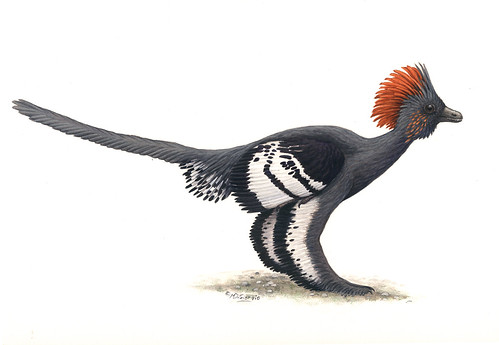
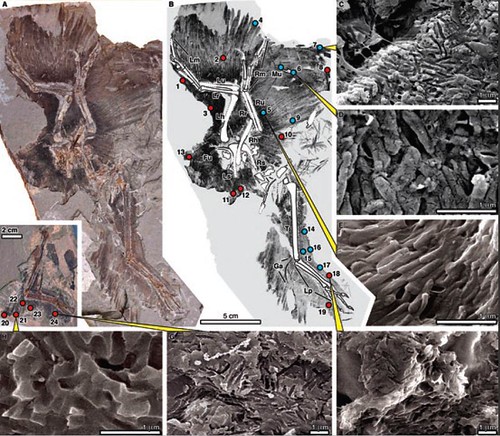
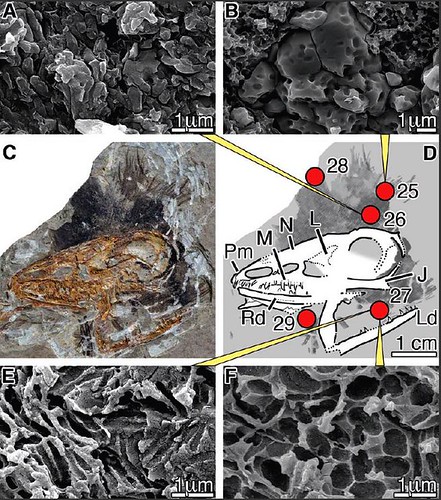
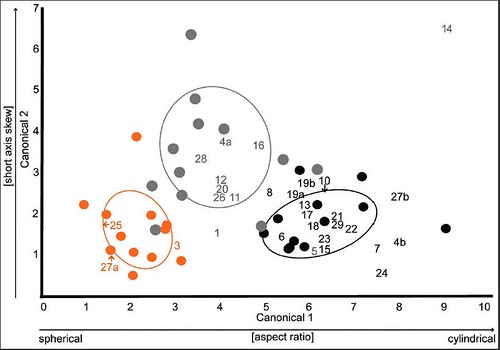
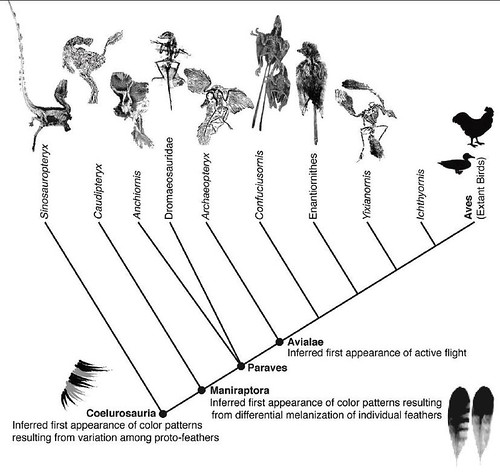
A great post Grrl, I now have further reading to do on my favourite group of animals.... thanks very much ( I think) so much reading so little time...ah well.
Brian wrote something about this on Dino Tracking, too.
http://blogs.smithsonianmag.com/dinosaur/2010/02/05/dinosaurs-now-in-li…
adrian: i worship you.
Grrl may not be entirely sober...
You should see what she's just done to the cat (and my laptop).
Bob,
or are you just concerned about "deferred idolatry": you worship Grrl, Grrl worships Adrian ergo you worship Adrian?
Nice.
When I was a kid, all the dinosaurs were grey or olive green. Then people started making them coloured, just because that seemed likely. Now we can actually figure out what at least some of those colours were.
It's wonderful that so much information can be obtained from a bunch of rocks.
well, SimonG, not sure what you're on about, but MY dinosaurs were always delightful shades of purple, neon green and scarlet red. it's nice to see that scientists are finally catching up.
Lovely bird 'innit? Beau'iful plumage! (Even if it isn't a Norwegian Blue.)
Good post. Learned something new.
Unfortunately that means I will forget something tonight. I hope it isn't anything important.
@MadScientist,
Yeah but... 'E's not pinin'! 'E's passed on! This parrot is no more! He has ceased to be! 'E's expired and gone to meet 'is maker! 'E's a stiff! Bereft of life, 'e rests in peace! If you hadn't nailed 'im to the perch 'e'd be pushing up the daisies! 'Is metabolic processes are now 'istory! 'E's off the twig! 'E's kicked the bucket, 'e's shuffled off 'is mortal coil, run down the curtain and joined the bleedin' choir invisibile!! THIS IS AN EX-PARROT!!
Just re-visited the comments and blushing madly!!
my son just asked me two weeks ago.
"mommy how do people know the color of dinosaurs?"
Now I have an answer,
Thanks for this post.
That's funny - It could be a Norwegian Blue, if what I heard elsewhere is correct and blue pigment isn't shown by this technique! Ha!
well, SimonG, not sure what you're on about, but MY dinosaurs were always delightful shades of purple, neon green and scarlet red.
Noo!!! Not purple!!
If you want to see a 360-degree view of Anchiornis huxleyi in all his stripey glory, check out this spinning graphic on the National Geographic News site: http://news.nationalgeographic.com/news/2010/01/100127-dinosaurs-color-…
Amazing. I can't quite wrap my brain around the possibility that feathers evolved first not for flight but some other purpose. A mind-bender, somehow. Thanks for the post. Love the dino version of Woody Woodpecker.